HI6006 - Competitive Strategy: Key Strategy Development Tools
VerifiedAdded on 2023/01/11
|9
|1779
|72
Essay
AI Summary
This essay provides a comprehensive overview of three key strategy development tools: Pestel analysis, Ansoff matrix, and Porter's generic strategies. The essay begins by introducing the importance of strategic planning in business, followed by an in-depth analysis of each model. Pestel analysis examines the political, economic, social, technological, environmental, and legal factors impacting businesses. The Ansoff matrix explores market penetration, product development, market development, and diversification strategies. Porter's generic strategies, including cost leadership, differentiation, and focus strategies, are also discussed. The essay includes practical applications and examples to illustrate how these models can be used to analyze market conditions, develop effective strategies, and enhance a company's competitive advantage. The essay concludes by emphasizing the importance of adapting strategies to changing market dynamics and ensuring business success.
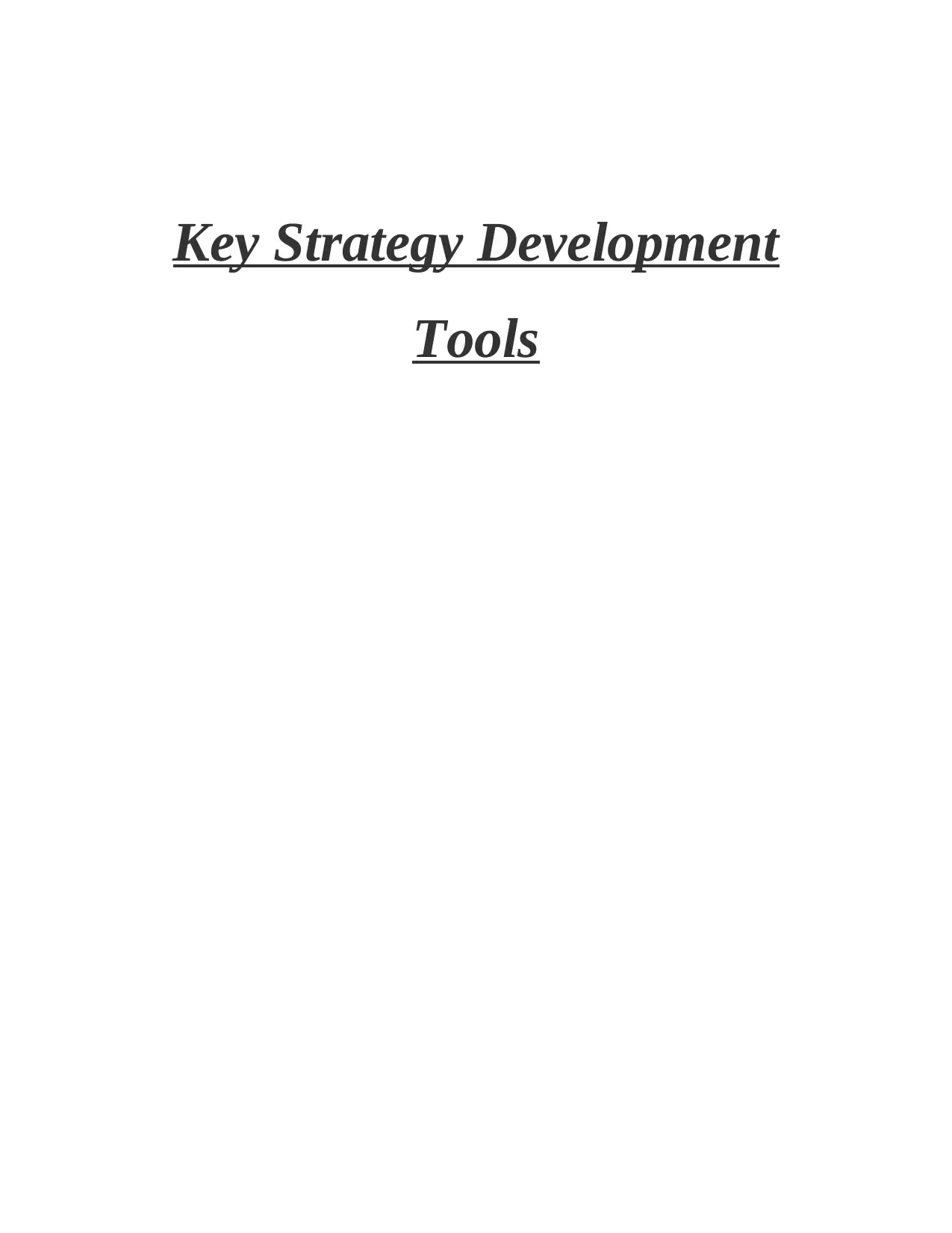
Key Strategy Development
Tools
Tools
Paraphrase This Document
Need a fresh take? Get an instant paraphrase of this document with our AI Paraphraser
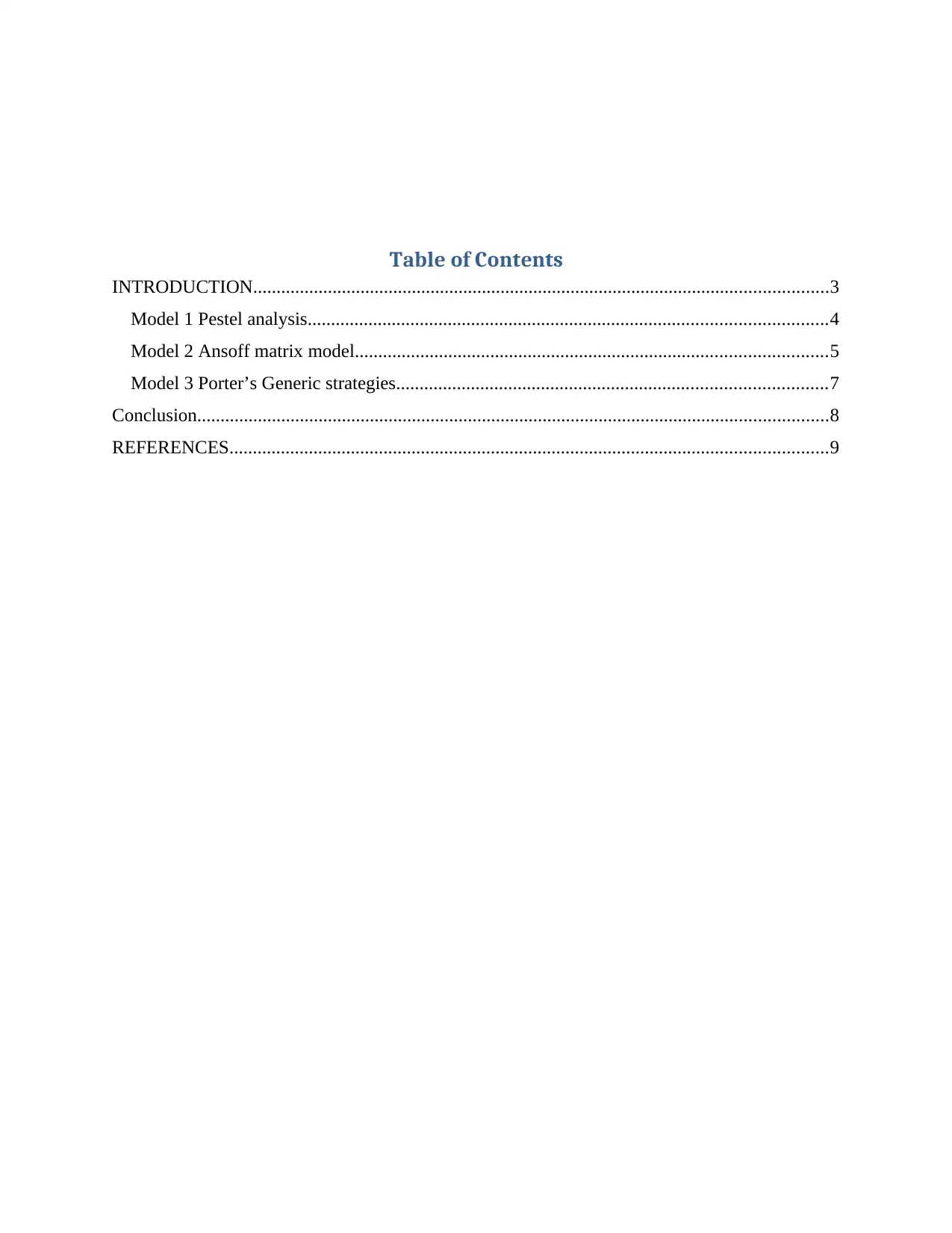
Table of Contents
INTRODUCTION...........................................................................................................................3
Model 1 Pestel analysis...............................................................................................................4
Model 2 Ansoff matrix model.....................................................................................................5
Model 3 Porter’s Generic strategies............................................................................................7
Conclusion.......................................................................................................................................8
REFERENCES................................................................................................................................9
INTRODUCTION...........................................................................................................................3
Model 1 Pestel analysis...............................................................................................................4
Model 2 Ansoff matrix model.....................................................................................................5
Model 3 Porter’s Generic strategies............................................................................................7
Conclusion.......................................................................................................................................8
REFERENCES................................................................................................................................9
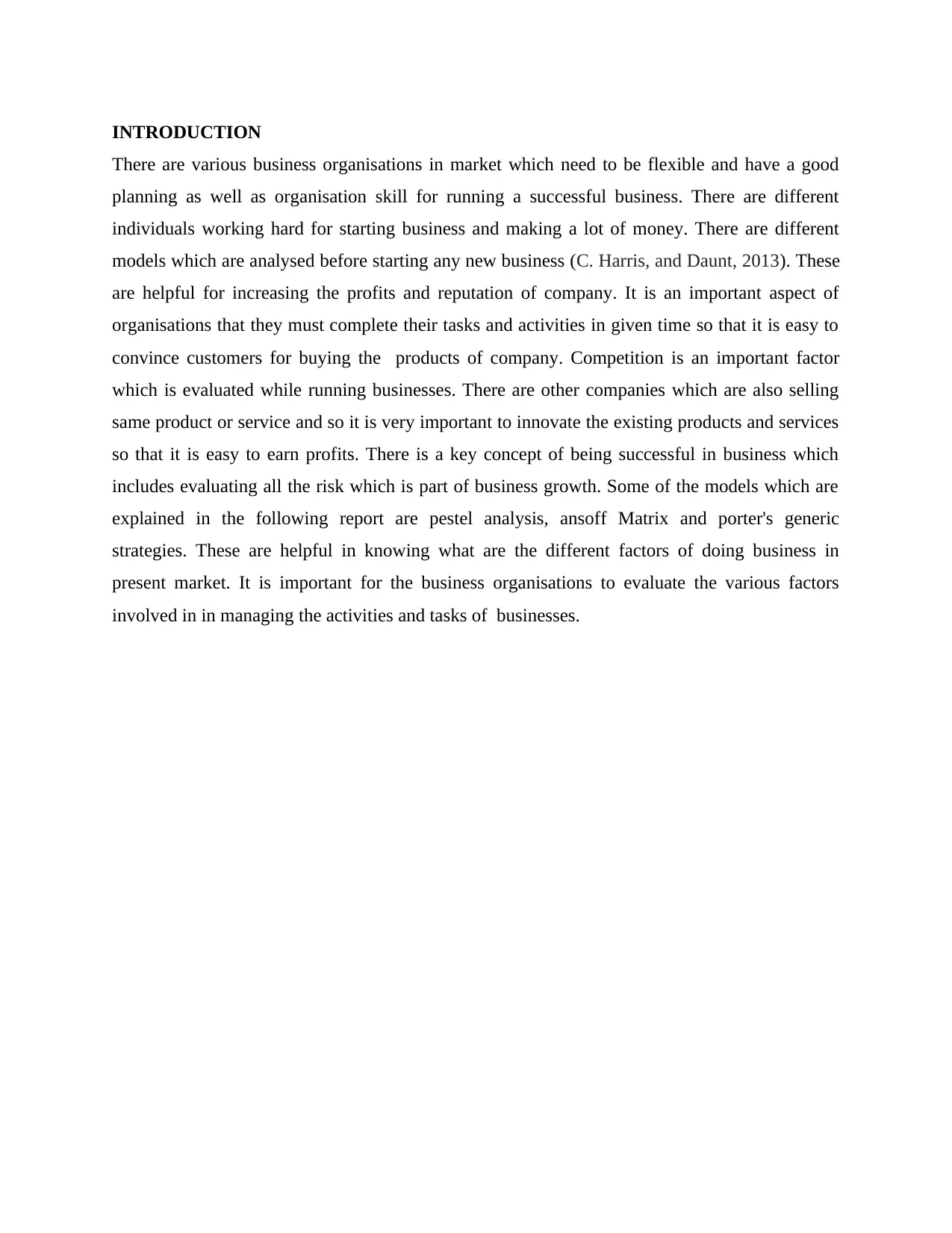
INTRODUCTION
There are various business organisations in market which need to be flexible and have a good
planning as well as organisation skill for running a successful business. There are different
individuals working hard for starting business and making a lot of money. There are different
models which are analysed before starting any new business (C. Harris, and Daunt, 2013). These
are helpful for increasing the profits and reputation of company. It is an important aspect of
organisations that they must complete their tasks and activities in given time so that it is easy to
convince customers for buying the products of company. Competition is an important factor
which is evaluated while running businesses. There are other companies which are also selling
same product or service and so it is very important to innovate the existing products and services
so that it is easy to earn profits. There is a key concept of being successful in business which
includes evaluating all the risk which is part of business growth. Some of the models which are
explained in the following report are pestel analysis, ansoff Matrix and porter's generic
strategies. These are helpful in knowing what are the different factors of doing business in
present market. It is important for the business organisations to evaluate the various factors
involved in in managing the activities and tasks of businesses.
There are various business organisations in market which need to be flexible and have a good
planning as well as organisation skill for running a successful business. There are different
individuals working hard for starting business and making a lot of money. There are different
models which are analysed before starting any new business (C. Harris, and Daunt, 2013). These
are helpful for increasing the profits and reputation of company. It is an important aspect of
organisations that they must complete their tasks and activities in given time so that it is easy to
convince customers for buying the products of company. Competition is an important factor
which is evaluated while running businesses. There are other companies which are also selling
same product or service and so it is very important to innovate the existing products and services
so that it is easy to earn profits. There is a key concept of being successful in business which
includes evaluating all the risk which is part of business growth. Some of the models which are
explained in the following report are pestel analysis, ansoff Matrix and porter's generic
strategies. These are helpful in knowing what are the different factors of doing business in
present market. It is important for the business organisations to evaluate the various factors
involved in in managing the activities and tasks of businesses.
⊘ This is a preview!⊘
Do you want full access?
Subscribe today to unlock all pages.

Trusted by 1+ million students worldwide
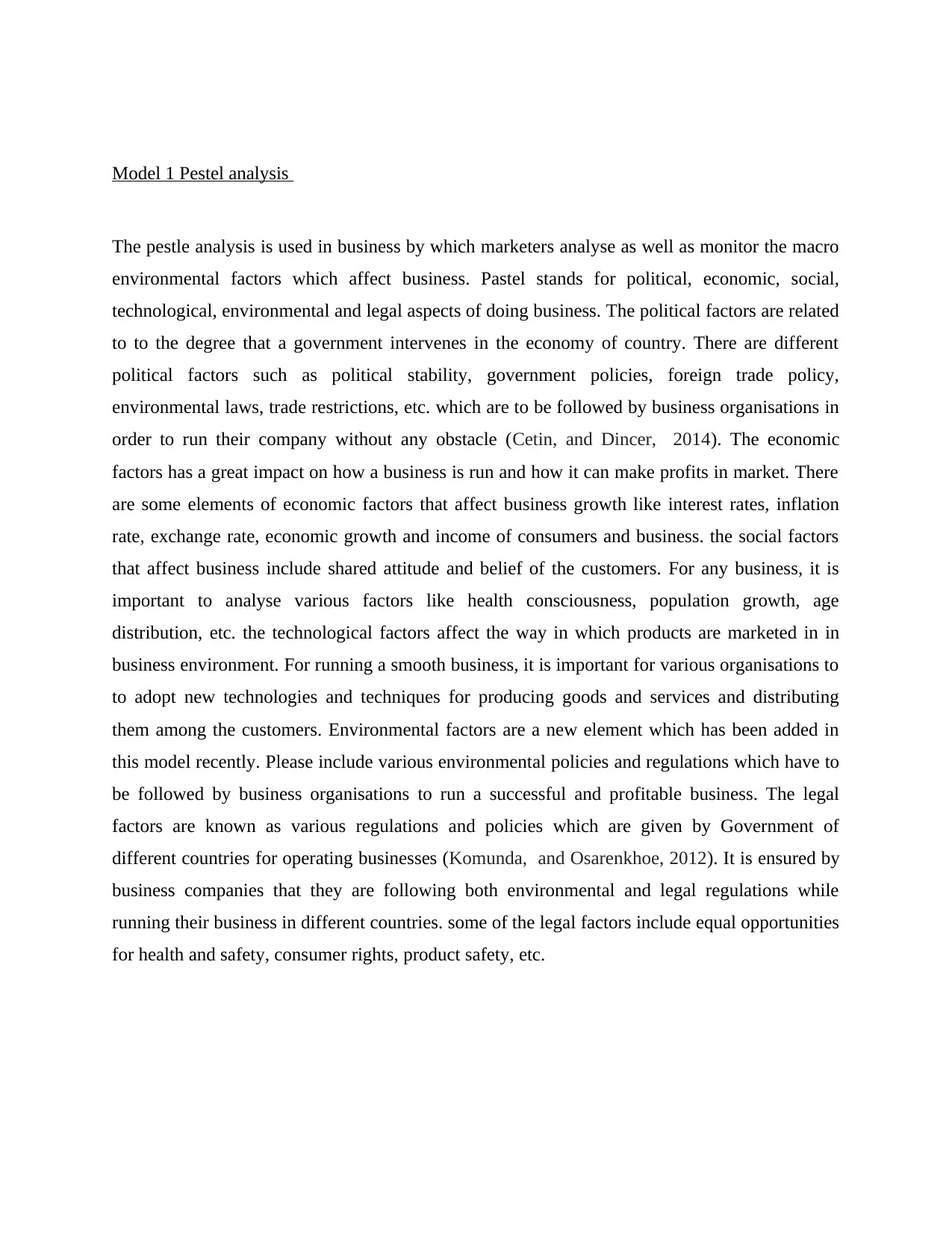
Model 1 Pestel analysis
The pestle analysis is used in business by which marketers analyse as well as monitor the macro
environmental factors which affect business. Pastel stands for political, economic, social,
technological, environmental and legal aspects of doing business. The political factors are related
to to the degree that a government intervenes in the economy of country. There are different
political factors such as political stability, government policies, foreign trade policy,
environmental laws, trade restrictions, etc. which are to be followed by business organisations in
order to run their company without any obstacle (Cetin, and Dincer, 2014). The economic
factors has a great impact on how a business is run and how it can make profits in market. There
are some elements of economic factors that affect business growth like interest rates, inflation
rate, exchange rate, economic growth and income of consumers and business. the social factors
that affect business include shared attitude and belief of the customers. For any business, it is
important to analyse various factors like health consciousness, population growth, age
distribution, etc. the technological factors affect the way in which products are marketed in in
business environment. For running a smooth business, it is important for various organisations to
to adopt new technologies and techniques for producing goods and services and distributing
them among the customers. Environmental factors are a new element which has been added in
this model recently. Please include various environmental policies and regulations which have to
be followed by business organisations to run a successful and profitable business. The legal
factors are known as various regulations and policies which are given by Government of
different countries for operating businesses (Komunda, and Osarenkhoe, 2012). It is ensured by
business companies that they are following both environmental and legal regulations while
running their business in different countries. some of the legal factors include equal opportunities
for health and safety, consumer rights, product safety, etc.
The pestle analysis is used in business by which marketers analyse as well as monitor the macro
environmental factors which affect business. Pastel stands for political, economic, social,
technological, environmental and legal aspects of doing business. The political factors are related
to to the degree that a government intervenes in the economy of country. There are different
political factors such as political stability, government policies, foreign trade policy,
environmental laws, trade restrictions, etc. which are to be followed by business organisations in
order to run their company without any obstacle (Cetin, and Dincer, 2014). The economic
factors has a great impact on how a business is run and how it can make profits in market. There
are some elements of economic factors that affect business growth like interest rates, inflation
rate, exchange rate, economic growth and income of consumers and business. the social factors
that affect business include shared attitude and belief of the customers. For any business, it is
important to analyse various factors like health consciousness, population growth, age
distribution, etc. the technological factors affect the way in which products are marketed in in
business environment. For running a smooth business, it is important for various organisations to
to adopt new technologies and techniques for producing goods and services and distributing
them among the customers. Environmental factors are a new element which has been added in
this model recently. Please include various environmental policies and regulations which have to
be followed by business organisations to run a successful and profitable business. The legal
factors are known as various regulations and policies which are given by Government of
different countries for operating businesses (Komunda, and Osarenkhoe, 2012). It is ensured by
business companies that they are following both environmental and legal regulations while
running their business in different countries. some of the legal factors include equal opportunities
for health and safety, consumer rights, product safety, etc.
Paraphrase This Document
Need a fresh take? Get an instant paraphrase of this document with our AI Paraphraser
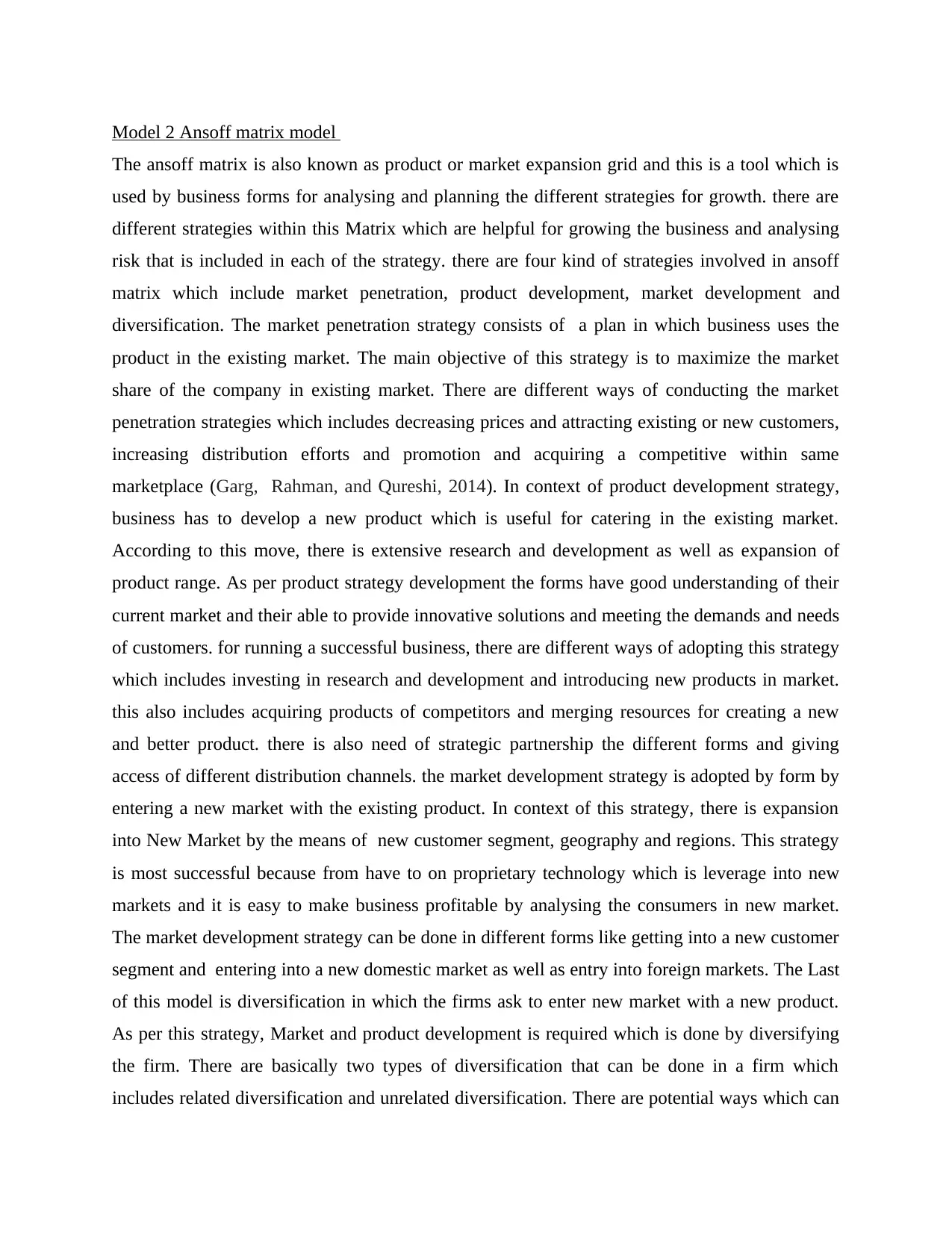
Model 2 Ansoff matrix model
The ansoff matrix is also known as product or market expansion grid and this is a tool which is
used by business forms for analysing and planning the different strategies for growth. there are
different strategies within this Matrix which are helpful for growing the business and analysing
risk that is included in each of the strategy. there are four kind of strategies involved in ansoff
matrix which include market penetration, product development, market development and
diversification. The market penetration strategy consists of a plan in which business uses the
product in the existing market. The main objective of this strategy is to maximize the market
share of the company in existing market. There are different ways of conducting the market
penetration strategies which includes decreasing prices and attracting existing or new customers,
increasing distribution efforts and promotion and acquiring a competitive within same
marketplace (Garg, Rahman, and Qureshi, 2014). In context of product development strategy,
business has to develop a new product which is useful for catering in the existing market.
According to this move, there is extensive research and development as well as expansion of
product range. As per product strategy development the forms have good understanding of their
current market and their able to provide innovative solutions and meeting the demands and needs
of customers. for running a successful business, there are different ways of adopting this strategy
which includes investing in research and development and introducing new products in market.
this also includes acquiring products of competitors and merging resources for creating a new
and better product. there is also need of strategic partnership the different forms and giving
access of different distribution channels. the market development strategy is adopted by form by
entering a new market with the existing product. In context of this strategy, there is expansion
into New Market by the means of new customer segment, geography and regions. This strategy
is most successful because from have to on proprietary technology which is leverage into new
markets and it is easy to make business profitable by analysing the consumers in new market.
The market development strategy can be done in different forms like getting into a new customer
segment and entering into a new domestic market as well as entry into foreign markets. The Last
of this model is diversification in which the firms ask to enter new market with a new product.
As per this strategy, Market and product development is required which is done by diversifying
the firm. There are basically two types of diversification that can be done in a firm which
includes related diversification and unrelated diversification. There are potential ways which can
The ansoff matrix is also known as product or market expansion grid and this is a tool which is
used by business forms for analysing and planning the different strategies for growth. there are
different strategies within this Matrix which are helpful for growing the business and analysing
risk that is included in each of the strategy. there are four kind of strategies involved in ansoff
matrix which include market penetration, product development, market development and
diversification. The market penetration strategy consists of a plan in which business uses the
product in the existing market. The main objective of this strategy is to maximize the market
share of the company in existing market. There are different ways of conducting the market
penetration strategies which includes decreasing prices and attracting existing or new customers,
increasing distribution efforts and promotion and acquiring a competitive within same
marketplace (Garg, Rahman, and Qureshi, 2014). In context of product development strategy,
business has to develop a new product which is useful for catering in the existing market.
According to this move, there is extensive research and development as well as expansion of
product range. As per product strategy development the forms have good understanding of their
current market and their able to provide innovative solutions and meeting the demands and needs
of customers. for running a successful business, there are different ways of adopting this strategy
which includes investing in research and development and introducing new products in market.
this also includes acquiring products of competitors and merging resources for creating a new
and better product. there is also need of strategic partnership the different forms and giving
access of different distribution channels. the market development strategy is adopted by form by
entering a new market with the existing product. In context of this strategy, there is expansion
into New Market by the means of new customer segment, geography and regions. This strategy
is most successful because from have to on proprietary technology which is leverage into new
markets and it is easy to make business profitable by analysing the consumers in new market.
The market development strategy can be done in different forms like getting into a new customer
segment and entering into a new domestic market as well as entry into foreign markets. The Last
of this model is diversification in which the firms ask to enter new market with a new product.
As per this strategy, Market and product development is required which is done by diversifying
the firm. There are basically two types of diversification that can be done in a firm which
includes related diversification and unrelated diversification. There are potential ways which can

be we realise between the existing business and new product development. The unrelated
diversification means the synergies which are present between existing business and new product
or market.
diversification means the synergies which are present between existing business and new product
or market.
⊘ This is a preview!⊘
Do you want full access?
Subscribe today to unlock all pages.

Trusted by 1+ million students worldwide
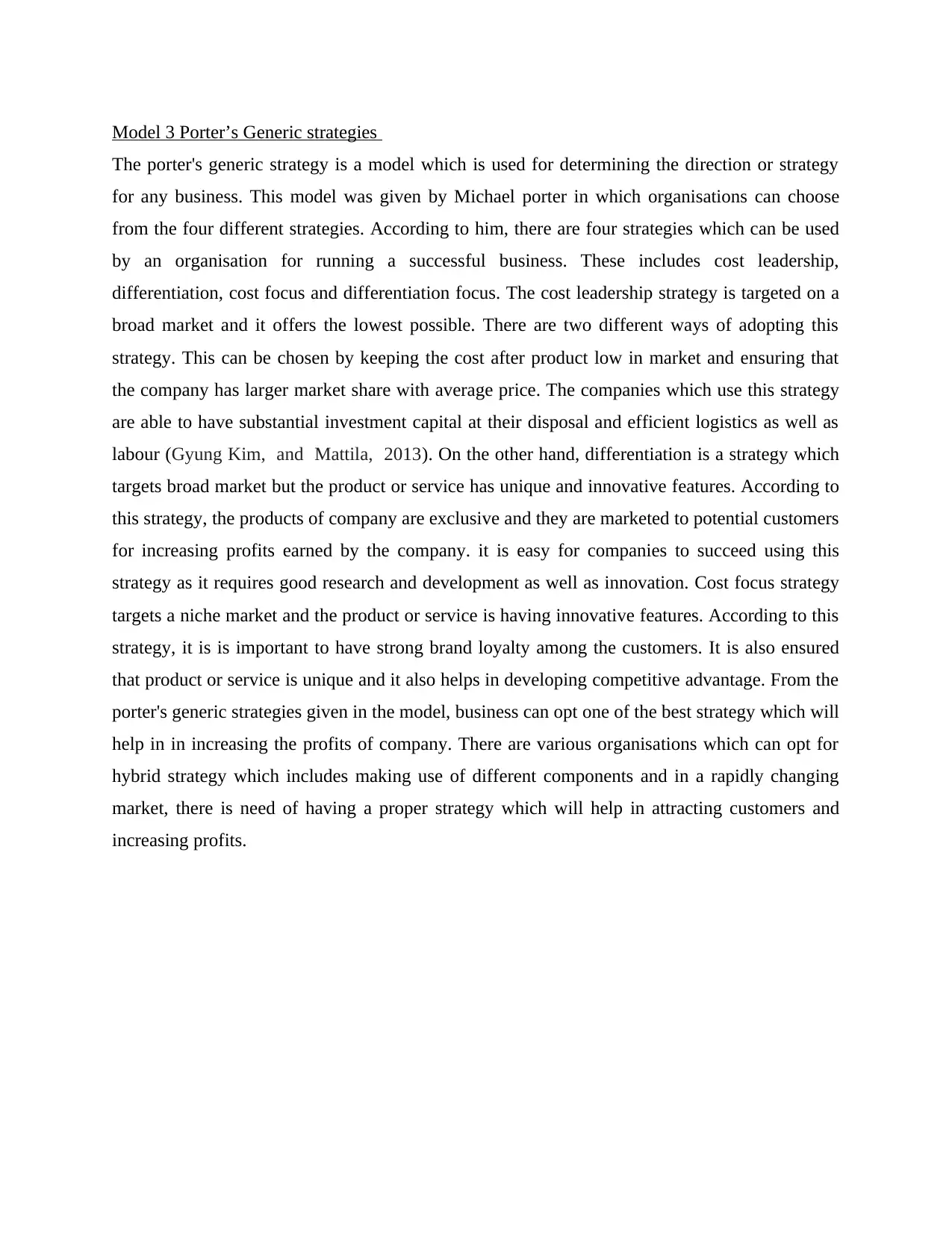
Model 3 Porter’s Generic strategies
The porter's generic strategy is a model which is used for determining the direction or strategy
for any business. This model was given by Michael porter in which organisations can choose
from the four different strategies. According to him, there are four strategies which can be used
by an organisation for running a successful business. These includes cost leadership,
differentiation, cost focus and differentiation focus. The cost leadership strategy is targeted on a
broad market and it offers the lowest possible. There are two different ways of adopting this
strategy. This can be chosen by keeping the cost after product low in market and ensuring that
the company has larger market share with average price. The companies which use this strategy
are able to have substantial investment capital at their disposal and efficient logistics as well as
labour (Gyung Kim, and Mattila, 2013). On the other hand, differentiation is a strategy which
targets broad market but the product or service has unique and innovative features. According to
this strategy, the products of company are exclusive and they are marketed to potential customers
for increasing profits earned by the company. it is easy for companies to succeed using this
strategy as it requires good research and development as well as innovation. Cost focus strategy
targets a niche market and the product or service is having innovative features. According to this
strategy, it is is important to have strong brand loyalty among the customers. It is also ensured
that product or service is unique and it also helps in developing competitive advantage. From the
porter's generic strategies given in the model, business can opt one of the best strategy which will
help in in increasing the profits of company. There are various organisations which can opt for
hybrid strategy which includes making use of different components and in a rapidly changing
market, there is need of having a proper strategy which will help in attracting customers and
increasing profits.
The porter's generic strategy is a model which is used for determining the direction or strategy
for any business. This model was given by Michael porter in which organisations can choose
from the four different strategies. According to him, there are four strategies which can be used
by an organisation for running a successful business. These includes cost leadership,
differentiation, cost focus and differentiation focus. The cost leadership strategy is targeted on a
broad market and it offers the lowest possible. There are two different ways of adopting this
strategy. This can be chosen by keeping the cost after product low in market and ensuring that
the company has larger market share with average price. The companies which use this strategy
are able to have substantial investment capital at their disposal and efficient logistics as well as
labour (Gyung Kim, and Mattila, 2013). On the other hand, differentiation is a strategy which
targets broad market but the product or service has unique and innovative features. According to
this strategy, the products of company are exclusive and they are marketed to potential customers
for increasing profits earned by the company. it is easy for companies to succeed using this
strategy as it requires good research and development as well as innovation. Cost focus strategy
targets a niche market and the product or service is having innovative features. According to this
strategy, it is is important to have strong brand loyalty among the customers. It is also ensured
that product or service is unique and it also helps in developing competitive advantage. From the
porter's generic strategies given in the model, business can opt one of the best strategy which will
help in in increasing the profits of company. There are various organisations which can opt for
hybrid strategy which includes making use of different components and in a rapidly changing
market, there is need of having a proper strategy which will help in attracting customers and
increasing profits.
Paraphrase This Document
Need a fresh take? Get an instant paraphrase of this document with our AI Paraphraser
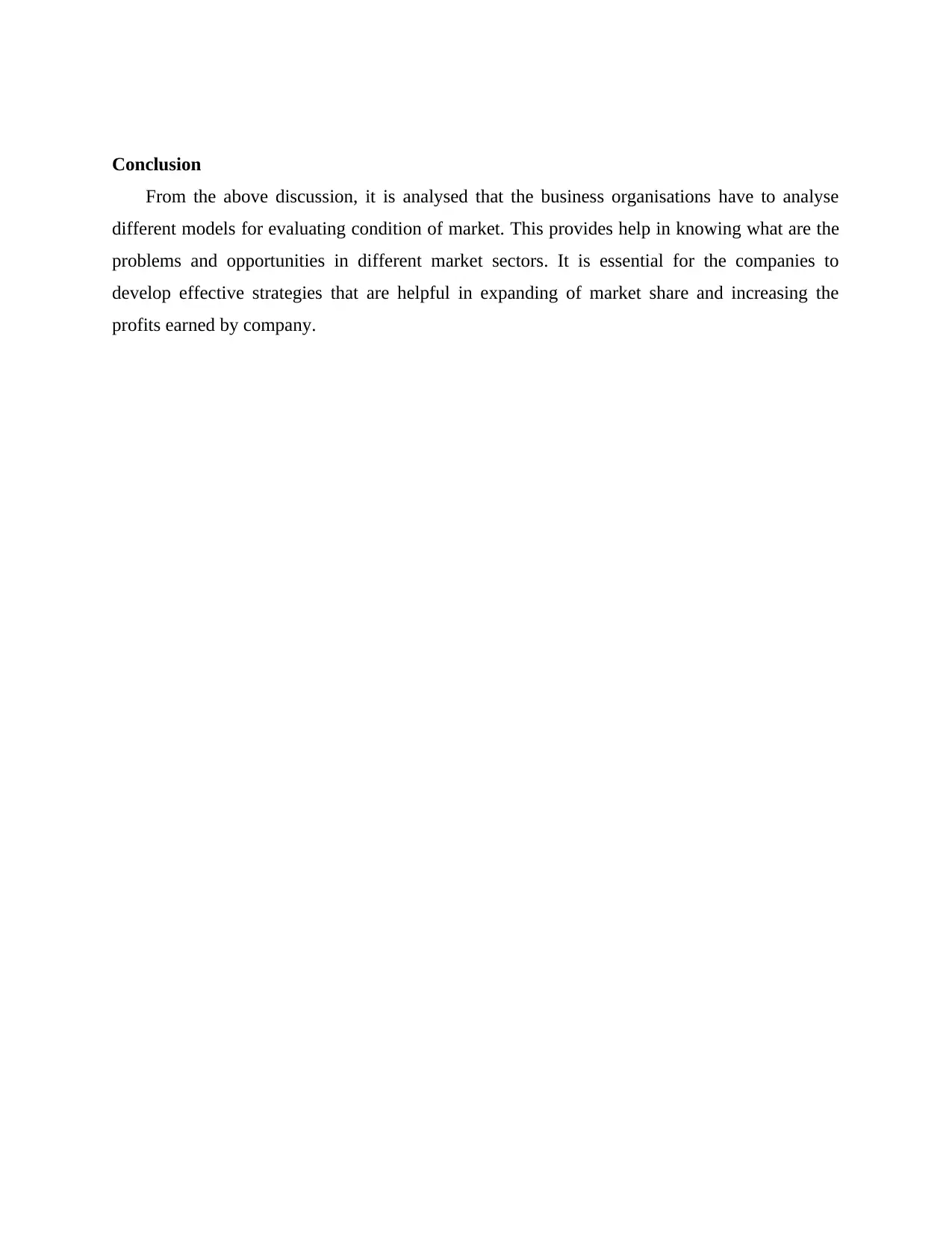
Conclusion
From the above discussion, it is analysed that the business organisations have to analyse
different models for evaluating condition of market. This provides help in knowing what are the
problems and opportunities in different market sectors. It is essential for the companies to
develop effective strategies that are helpful in expanding of market share and increasing the
profits earned by company.
From the above discussion, it is analysed that the business organisations have to analyse
different models for evaluating condition of market. This provides help in knowing what are the
problems and opportunities in different market sectors. It is essential for the companies to
develop effective strategies that are helpful in expanding of market share and increasing the
profits earned by company.
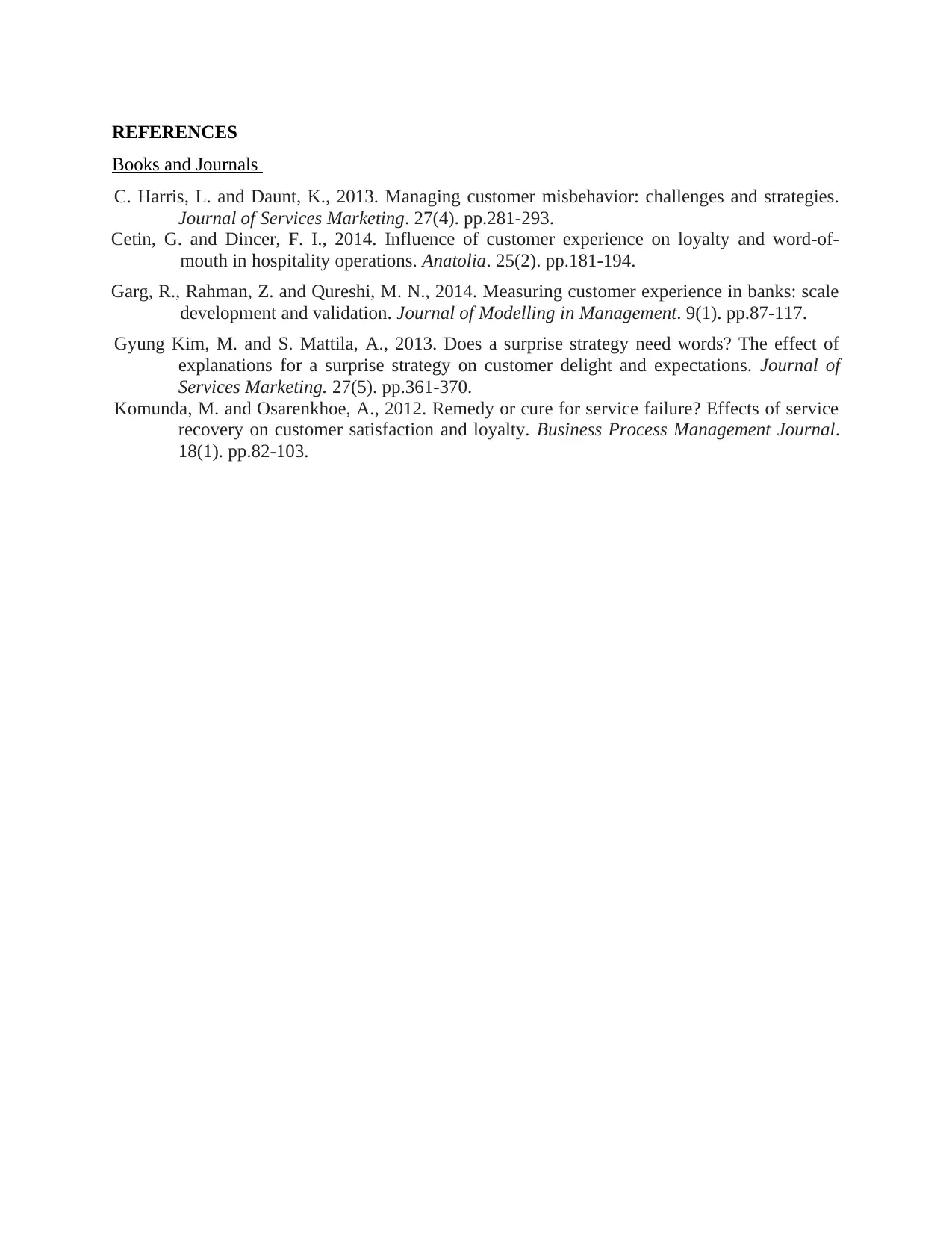
REFERENCES
Books and Journals
C. Harris, L. and Daunt, K., 2013. Managing customer misbehavior: challenges and strategies.
Journal of Services Marketing. 27(4). pp.281-293.
Cetin, G. and Dincer, F. I., 2014. Influence of customer experience on loyalty and word-of-
mouth in hospitality operations. Anatolia. 25(2). pp.181-194.
Garg, R., Rahman, Z. and Qureshi, M. N., 2014. Measuring customer experience in banks: scale
development and validation. Journal of Modelling in Management. 9(1). pp.87-117.
Gyung Kim, M. and S. Mattila, A., 2013. Does a surprise strategy need words? The effect of
explanations for a surprise strategy on customer delight and expectations. Journal of
Services Marketing. 27(5). pp.361-370.
Komunda, M. and Osarenkhoe, A., 2012. Remedy or cure for service failure? Effects of service
recovery on customer satisfaction and loyalty. Business Process Management Journal.
18(1). pp.82-103.
Books and Journals
C. Harris, L. and Daunt, K., 2013. Managing customer misbehavior: challenges and strategies.
Journal of Services Marketing. 27(4). pp.281-293.
Cetin, G. and Dincer, F. I., 2014. Influence of customer experience on loyalty and word-of-
mouth in hospitality operations. Anatolia. 25(2). pp.181-194.
Garg, R., Rahman, Z. and Qureshi, M. N., 2014. Measuring customer experience in banks: scale
development and validation. Journal of Modelling in Management. 9(1). pp.87-117.
Gyung Kim, M. and S. Mattila, A., 2013. Does a surprise strategy need words? The effect of
explanations for a surprise strategy on customer delight and expectations. Journal of
Services Marketing. 27(5). pp.361-370.
Komunda, M. and Osarenkhoe, A., 2012. Remedy or cure for service failure? Effects of service
recovery on customer satisfaction and loyalty. Business Process Management Journal.
18(1). pp.82-103.
⊘ This is a preview!⊘
Do you want full access?
Subscribe today to unlock all pages.

Trusted by 1+ million students worldwide
1 out of 9
Related Documents
Your All-in-One AI-Powered Toolkit for Academic Success.
+13062052269
info@desklib.com
Available 24*7 on WhatsApp / Email
![[object Object]](/_next/static/media/star-bottom.7253800d.svg)
Unlock your academic potential
Copyright © 2020–2025 A2Z Services. All Rights Reserved. Developed and managed by ZUCOL.



